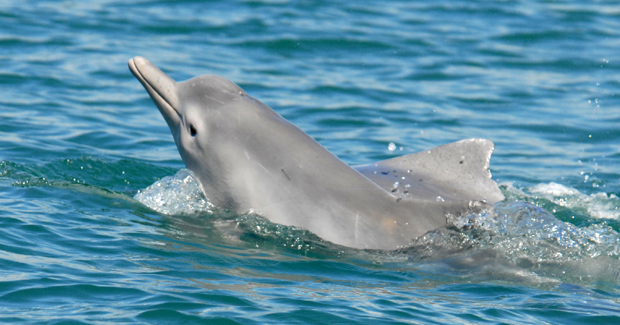This is perhaps the most personal work in the exhibition. It presents a maternal relationship between a chimera (based on the Australian humpback dolphin) and a prepubescent girl.
The Australian humpback dolphin has only recently been identified as its own species and they are sadly, already vulnerable, only between 2,500 and 10,000 exist. These beautiful mammals are affected by marine noise, plastic pollution and drowning from getting caught in shark nets — all the usual stupid stuff. They are magnificent and intelligent creatures who have so much in common with us, including complex social and parental relationships.
 |
|---|
| Australian humpback dolphin. (Photo: Guido J. Parra). |
| Learn more |
I’ve often depicted mother child relationships; I think in my mind I’m trying to valorise them. To give them cultural space and validation because I feel that mothering and nurturing is so undervalued in our culture.
This work is special to me because it’s a realistic portrait of my daughter Roxy, just before she started the journey to adulthood. Of course, this is her journey, but in some ways, it is also mine.
What we see in this work is essentially a ‘non-human animal other’ caring for a human. It’s a simple work but it’s pretty loaded.
Our culture has lots of dichotomies — pairs of ideas that are considered opposites — that we use to explain the world, and often control it. Think of ideas like nature and culture, male and female, black and white, human and animal. Now the problem with this way of thinking is not that these dichotomies don’t exist, or that the two sides aren’t different.
The problem arises when culture attaches the idea that one side of this pair is better than the other. We do that a lot, and that is a real problem because it’s both untrue and unfair. It also denies that there are usually just as many commonalities as differences.
When we put ‘mother nature’ on one side and ‘people’ on the other, we make it harder to realise that when we hurt nature, we hurt ourselves.
I feel that the role that women play culturally as mothers and carers has put care on the wrong side of an important/not important dichotomy in our culture, yet care is what we need now, more than anything. What does it matter about profit, or even new technologies, if there is no planet to live on? I think the humpback dolphins would get that.
When I make a big sculpture about care, I hope that I am saying that big sculptures don’t just have to be about important men in hats or on horseback. Maybe they can be about intimacy and care?
That’s why the carer is a chimera. Chimeras are based on the fact that we are more genetically similar to other animals than we are different. When I integrate human characteristics into other animals, I am highlighting our fundamental, common animalness.
I love that genetic research fundamentally destroys the human/animal divide. Sure, we are different from other animals, but only in the way that a dolphin is different from a seal. I feel like the more you look at these two figures together, the more you can see what connects them — rather than what separates them.
